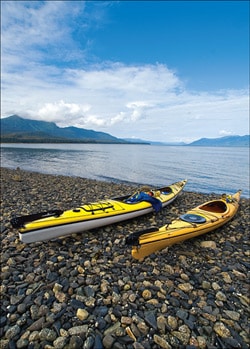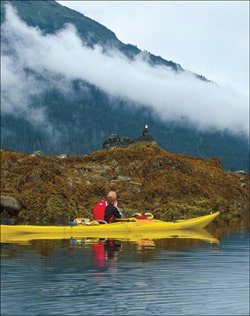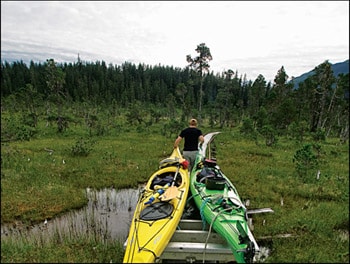Alaska: Alone In The Wild
From the April/May 2008 issue of ISLANDS magazine.
It's quiet here. i can barely make out the calls of faraway eagles over the rhythmic swishes of my kayak paddles. In every direction are snowcapped mountains towering above the temperate rainforest of southeast Alaska. I don't even want to utter a word, as if a voice would despoil the purity of the moment. I soak in the placid world of Admiralty Island while I can. Soon it will all be ripped away from me, and it will be my fault.
As I consider what I'm here to do, my palms sweat. I want to see an Ursus arctos horribilis — a "bear horrible." These 600-pound creatures armed with 6-inch claws have roamed this area for hundreds of thousands of years. Admiralty Island now has the world's highest concentration of these brown bears, about 1,700 roaming across its 1,700 square miles. That's more than in all of the lower 48 states. There's a special viewing area at a place called Pack Creek where I can get up close and personal. There's one catch: I have to go by myself.
The indigenous Tlingit people named the island Kootznoowoo, "fortress of the bears." Anywhere else the name might be dismissed as exaggerated lore, but not here. The island, officially called the Admiralty Island National Monument, is part of the federally designated Kootznoowoo Wilderness, made up of nearly a million acres of old-growth forest, rugged peaks and remote coastline. It's a beautiful place for a bear to get away from it all. To get here, I went through Alaska Above & Beyond, a top-notch outfi tter that handles logistics and supplies kayaks and gear. Guide Corey Denton and I took a half-hour ferry from Juneau across the Inside Passage to Oliver's Inlet on Admiralty Island. Left alone on the pebble-strewn beach, Corey and I readied our provisions for 12- mile-a-day wilderness paddling while scanning the dark barricade of trees. "If we suddenly encounter a bear at close range, never run — that can trigger a chase," Corey warned. He whipped out a can of pepper spray for me. I vowed to keep it at my side.

Now out on our kayaks, we work our way south along Admiralty's Seymour Canal, where humpback and Orca whales make recurring rounds during summer. There's not a soul in sight. In the saltwater shallows I see crabs, starfi sh and darting baitfi sh. A pod of harbor seals shoots beneath our hulls. We cross the channel to a nameless beach identifi ed only by GPS coordinates. We pitch tents and camp. The 10 p.m. sunset lights a panorama that hasn't changed since Alaska's brawny frontier days, when 18th-century Russian fur traders, Yankee whalers and grizzled prospectors plied these same waters. Darkness swallows us and so does my imagination. With every crackle and thud in the forest, I remind myself that deer, fox, beavers and mink roam Admiralty at night, too — not just bears.
The next morning, the miles pass easily as we paddle through a maze of small bays and white-sand beaches. We're close to shore when movement on a beachhead stops us cold. A female brown bear has just busted through the trees and is rooting along the beach. She faces us head-on and snorts. "Bears are good swimmers, right?" I ask Corey, eyeing 50 yards of water between me and the bear. "Very," he says. "But she's just letting us know who's boss. She won't swim if she doesn't have to." We keep moving, and the bear stays put. We camp on an islet just offshore from Pack Creek. Its namesake is Arthur Pack, a conservationist who lobbied for bear-protection measures enacted in 1934. The site is within the Stan Price State Wildlife Sanctuary, named after a man who lived in a cabin on Pack Creek in the 1950s. Price is known for having raised an orphaned bear cub, who in turn stayed in the area to raise cubs of its own. In the decades since, that harmony has continued.

As we get ready to turn in, Corey says of Pack Creek, "You'll be going alone." My eyes pop. In my scramble to travel to Alaska, I let Corey and his fellow guides handle all the prep and secure the permits. Evidently, I didn't read the fine print. My outfitter isn't permitted to accompany clients. Surely a Forest Service ranger will give me the low-down on bear etiquette and safety, then escort me into the bears' world, right? That's a no. Apparently, the Forest Service operates Pack Creek as a do-it-yourself program. I consider what might happen to me when I'm surrounded by 1,700 bears and my pepper spray runs out. But Corey throws out a factoid that's music to my ears: "Just so you know, no one's ever been attacked at Pack Creek." In the morning, I glide my kayak to the creek, where a ranger named Kristen Stelck meets me. She's carrying a rifl e. I sign a logbook — and a disclaimer — as she spells out that I'll be doing a one-mile hike through the forest to an elevated platform. Along the route and from that perch, I'll have a high probability of seeing bears. She asks, "You're comfortable with this, aren't you?"
Uh, yes, though I soon fi nd that I'm depleting my supply of adrenaline for the year. I start the hike and see large areas where ferns and other greenery seem to be fl attened by a steamroller — in other words, where bears lounge after a big meal. It's the longest 20-minute hike of my life. When I finally see the 30-foot-high platform, I almost break into a run. From there I see spawning salmon, the linchpin that makes Pack Creek what it is. Plenty of fish heads and bones lie about, the leftovers of bears who've grown finicky from abundance. But I see no bears. An hour passes; still nothing. When a light squall moves in, I decide that the bears probably have better sense than I to stay out of the rain. Retracing my route back to the beach, I see a trail to a viewing area near the dilapidated Price home that overlooks the tidal fl ats. The squall has picked up. My dry tent sounds pretty good, but I'll be leaving Pack Creek tomorrow. This is my last chance.
The walk only takes a few minutes. At the end of the trail, I see what all the fuss is about. There's a large female with two yearling cubs just 100 yards away. Mother gently swats her cubs aside while landing a salmon. Toward the tidal fl ats I see a gawky adolescent who chases a dozen fish before landing one. In the distance I hear a crashing noise coming from the forest, and then I see the biggest bruin yet: A massive male lumbers onto the scene as though he owns the place. With his appearance, the other bears vanish. I watch with my heart in my throat, looking through binoculars. The male raises his head and I see his face straight-on, but it's his teeth and claws that I especially notice. I take this as my cue to head back to my kayak. I'll do my part to keep Pack Creek's safety record perfect.
